Goldenrod: description, types and varieties, planting and care features
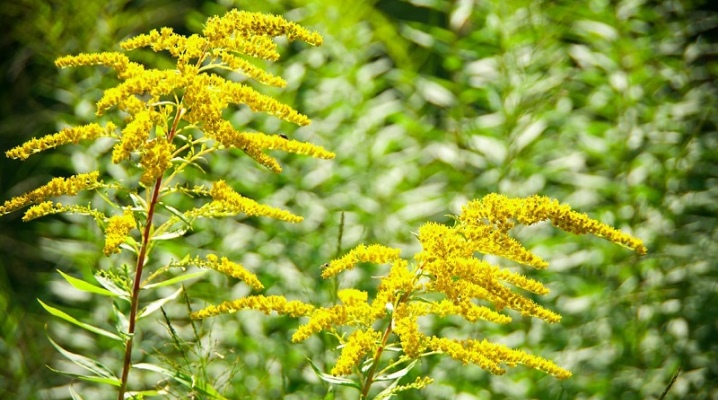
Goldenrod is a beautiful and fragrant plant that belongs to the Astrov family... In nature, it can be found almost throughout the temperate-climatic part of Eurasia. The most attractive to the plant is provided by fragrant beautiful flowers, which, in addition to aesthetics, also have medicinal properties.
There are a lot of synonymous, common names for this plant. It is often called a bone worm, iron ore, solidago. Gardeners love goldenrod for ease of care, beauty and rapid growth... Let us consider in more detail the description, types and varieties, features of planting and care of goldenrod.

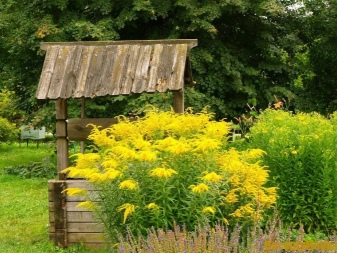
Description
Goldenrod or solidago refers to herbaceous perennials with a raceme-like rhizome. The roots of the plant are quite powerful, strong, deep. On the surface of the soil, a shoot is not too branched, of a simple type. The height of the grass is up to 1 meter, the type of stem is longitudinal, straight. The stem is covered with satin-type bark, the color is purple or emerald. The foliage of the grass has a juicy shade of green, looks like an oval or egg in shape. The edges are sawtooth, with jagged edges. At the bottom, the foliage grows narrower and elongated, somewhat similar to willow leaves.
Flowering begins in late spring and lasts until autumn, the yellow beauty of the inflorescences is very impressive. The flower is formed by bell-type buds, the color is yellow, lemon. In the middle, the shade is close to chestnut.
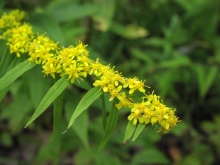
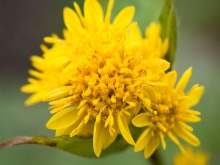
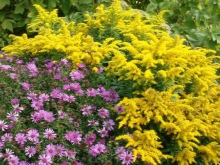
The aroma of flowers is intense. At the end of flowering, a fruit is formed in the form of a cylindrical achene with longitudinal ribs.
Non-specialists often confuse the plant with ragweed, garden mimosa. However, goldenrod is significantly different from them. Ragweed, for example, looks more like wormwood, the flowers form into an inflorescence like an ear, rather than a bell. The stem has grooves, bristles. Goldenrod is considered an aggressive plant, as one plant is capable of dispersing about 100,000 seeds, which are almost completely germinated.
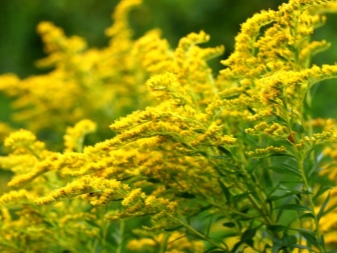
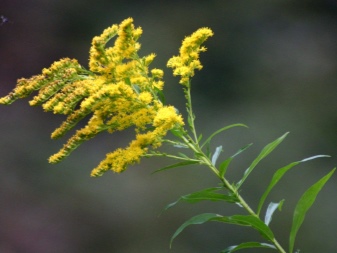
Types and varieties
Goldenrod has a very large species diversity.
Ordinary
This species is also called the golden rod, it can be called the most common... The height can reach 100 cm, the stem is straight, does not branch, the foliage is ovoid, with a sharpness and notches along the border. Blossoming lemon tone, tubular-shaped inflorescence like a broom, it is formed by small baskets. They begin to bloom towards the end of summer. The common goldenrod grows naturally in mountain forests, well-lit steppes, next to water. He is an excellent honey plant.
It looks great in the form of bouquets in the landscape. Due to its medicinal properties, it is often harvested to create medicinal collections.
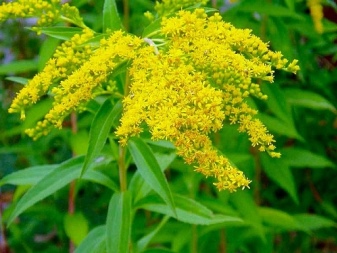
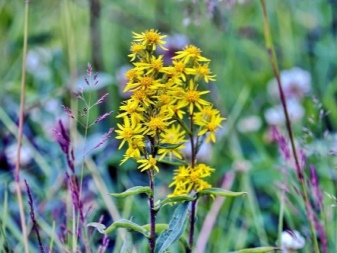
Daursky
The homeland of this bushy species is Siberia. The bush grows about a meter in height, the shoots are of a simple type, not branched, but very strong. Branching is observed only in the inflorescence area. The top of the stem is covered with small hairs, the bottom is absolutely naked. The foliage on the stem has shortened petioles, in the root zone the petioles are long. Sawtooth foliage can be lanceolate, ovoid or elongated in shape. The edging and veins on the foliage also have a slight hairiness. The inflorescence is small, narrow in brush type, it is formed from yellow baskets.
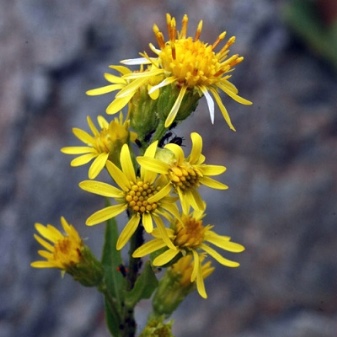
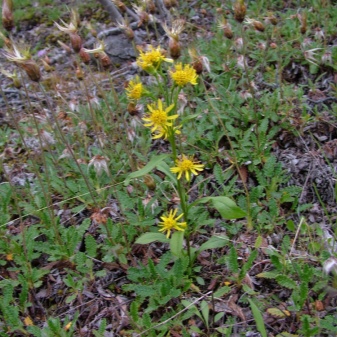
Canadian
This species is present in nature not only on the North American continent, but also in Eurasia. The Canadian goldenrod is outwardly similar to the common species, grows in thickets, grows very aggressively. The straight, powerful stem is up to one and a half meters high. Branching is observed at the top, the branches are very strong, covered with a large number of leaves. The stem color is dark or light green. The top of the stems is covered with a short pile.
The foliage is wide, the border is serrated, the leaf size is about 15 cm. The leaf plate is of the next type, has an elongated silhouette, the top is pointed, with three poorly distinguishable veins. The lower foliage has small teeth, with a shortened petiole, about 12 cm in size. This species blooms in August and captures autumn, the tone is yellow with a lemon undertone, the inflorescence baskets are small.
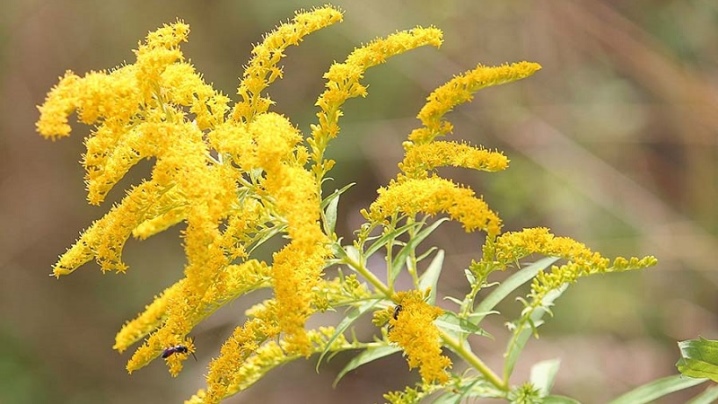
This decorative representative of the flora often becomes wild. It can be found in all regions of the country. The rhizomes suppress other plants due to the inhibitors they produce. There are quite a few garden forms of the Canadian goldenrod, and they are all popular due to their unpretentiousness and winter hardiness. Among the popular varieties, two are especially common.
- Patio. A low-growing representative, the height of the grass does not exceed 40 cm. The flowering is abundant, long-lasting. Inflorescences are small, yellow-lemon tone.
- Golden Glory. A very effective and highly decorative variety, with fluffy luxurious flowers, ideal for floristry. The diameter of the flower is from 1 to 10 mm, the dark green foliage reaches 15 cm in length. The bloom is bright yellow.
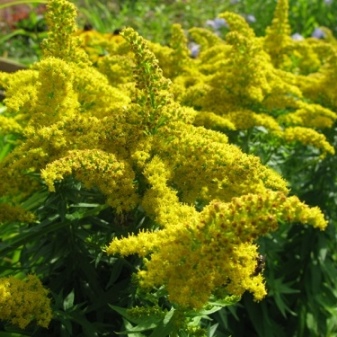
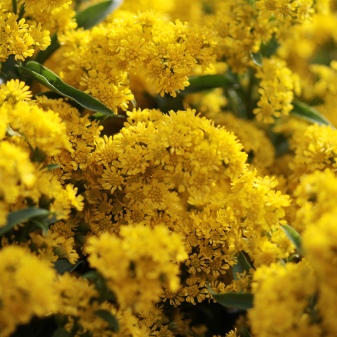
Hybrid
This representative of the family became the progenitor of a large varietal variety. All of them are undersized, with rich foliage, they are bred not only by professional gardeners, but also by amateurs. They are great for floristry.
- Dzintra. This variety begins to bloom in July and continues to delight with beauty until autumn. The bush is powerful, strong, but low - up to 60 cm. Thick shoots of dark green color with abundant foliage. The color of the glossy foliage is malachite, the leaves are narrowish in shape, like an oval. Umbrella-type inflorescences, dense, golden shade. After flowering, the shoot is cut off and new inflorescences are formed until autumn.
- Goldjunge. This variety is considered the most fragrant among the hybrids, rather high - more than 1 meter. The stem is quite graceful, but strong, the foliage is grayish from the turn, narrowish in silhouette with smooth edges. The paniculate inflorescences are dense, with exquisitely curved branches, stretching up to 40 cm in size, the color is yellow with gold. The baskets are very small. Flowering time is the last month of summer.
- Goldtanne. The tallest representative of this plant, the stems can be extended over two meters. The color of the powerfully dense stems is light green. The foliage is narrow, with sharp ends, a small number of teeth along the edge, the veins are visible well. The color is blue-green. The inflorescences are a large, dense panicle, the length is up to half a meter, the branches are beautifully bent. Flowers have a shade of straw at the very beginning of formation, then gradually acquire the tone of amber. This variety blooms in late September.
- Golden Dwarf. Stunted - up to 60 cm, the inflorescence stretches up to 17 cm in length, the shade of the baskets is saffron-yellow. This variety blooms in August, feels good both in the sun and in partial shade. He prefers moist soil.
- Perkeo... The height of the cone-shaped bush is about 60 cm, the shoots are distinguished by grace and strength, their color is pistachio. Emerald-colored foliage, abundant, narrowish, with sharp tips and smooth type. There are some teeth along the edge, there is a pile on the bottom. The inflorescences grow up to 17 cm in length, they are juicy, catchy clusters with small baskets of yellow gold color. This species blooms in July and pleases with its flowering until September.
- Pillare... Late columnar shrub, growing up to 90 cm in height.Shoots of a dense type, strong, shade of malachite. Abundant olive-toned foliage, oval-shaped, with sharp tips, few teeth along the edge. The inflorescence is straight and narrowish, like a short panicle, the length is no more than 15 cm. The predominant color is golden.
- The Golden Dwarf. Dwarf plant up to 50 cm in height, inflorescences stretch up to 17 cm in maximum length. Flowering is yellow, beginning in the last month of summer. This variety grows well in the sun and in partial shade, and thrives on wet soils. It is successfully used in floristry.
- Solidago Goldkind. This look looks great not only in cut, but also in border-type decoration. Flowering is distinguished by a bright yellow color, beginning in July. The leaves are lanceolate, the maximum stem height is 60 cm. The plant prefers sunny areas and well-drained soil.
- "Josephine". Quite compact plant, maximum height - 70 cm, erect stems with a rather dense crown. Shoots are covered with long leaves. This variety blooms in early summer, the inflorescences are large, formed from tiny baskets of a rich yellow palette.

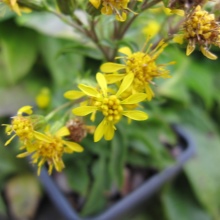
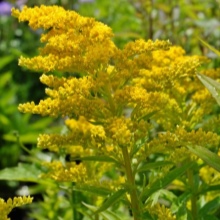
Supreme
This goldenrod is also called giant due to its impressive height - about 200 cm.This species grows effectively as a thicket. The leaves are bright emerald-juicy color. The inflorescences have the tonality of saffron, they stretch up to 40 cm in size. This variety blooms in August and blooms for a very long time. One of the most common varieties can be considered the highest goldenrod "Tara Gold" is very lush, with bright foliage and beautiful yellow inflorescences.
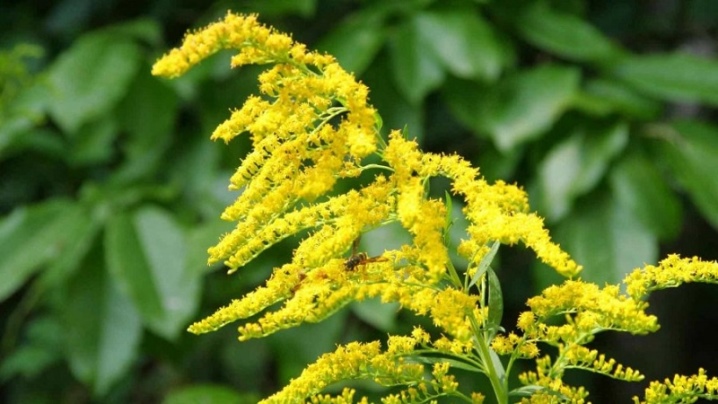
Solidago cutleri
Kutler's goldenrod is one of the smallest varieties. The foliage is oval in shape, up to 15 cm long, rough to the touch, has jagged edges. The leaves do not grow too abundantly, the inflorescences are short, like a brush or shield, the color is yellow-amber. Blooms from early autumn until frost. This variety became the progenitor of many varieties of the undersized type, the most popular are Robusta with a maximum size of 30 cm, Pyramidalis with a maximum height of 50 cm.
This variety looks great on lawn compositions, flower beds, rockeries.

Wrinkly
This tall perennial grows above 1 meter, the stem is straight, powerful, abundantly leafy. The foliage has a simple oval shape, there are teeth along the border, the tip is of a pointed type. Inflorescences resemble arcuate brushes and consist of small baskets. Outwardly, the inflorescence resembles a pyramid. The variety begins to bloom in September, feels good in the sun and in non-dry soil.
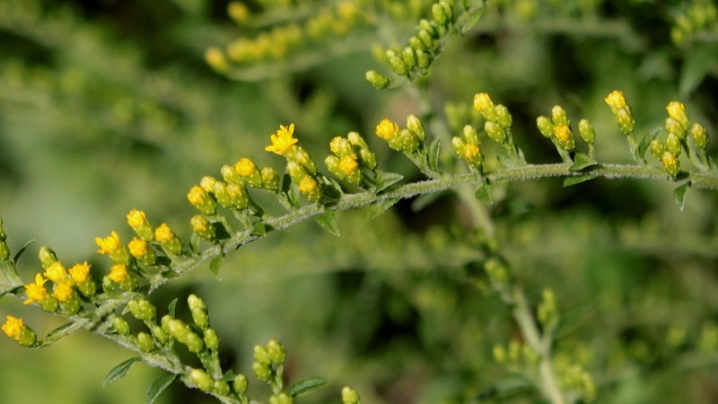
Landing features
Planting goldenrod on the site is not difficult, but time must be taken to assess the soil. It should be quite nutritious, it should be fertilized regularly with organic matter, compost. Goldenrod prefers moist fertile soils. If the soil is poor, you will need top dressing. Improving soil quality will result in abundant and luxurious flowering. The scarcity of the soil is reflected in the beauty and decorativeness of the plant. Compost is best suited for these purposes.
During self-sowing, some of the seeds become non-germinating, some plant varieties do not form seeds at all or they do not have time to ripen. That's why this representative of the flora is rarely bred with seeds. This must be done through seedlings, and can also be purchased ready-made in garden stores.
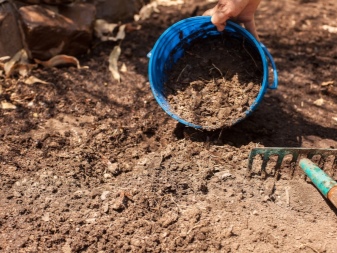
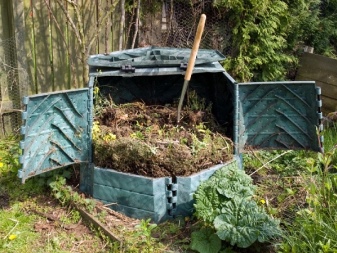
It is planted in open ground both in the spring and in the fall. Healthy, strong shoots with abundant foliage are suitable for these purposes. Do not plant plants with spots or insects.
Choosing a site is not difficult, both sunny and shaded areas are suitable. The optimal soil is wet and heavy, so you should not loosen the soil with sand and other methods. The gaps between the bushes should be about 40 cm, more, but not less. For one square meter, the amount is calculated depending on the variety - from 2 to 5 bushes on average.
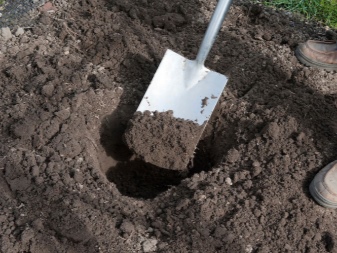
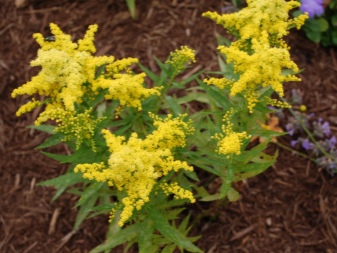
Subtleties of care
Goldenrod will not particularly burden with its presence on the site, it is unpretentious and very resilient... This is a great plant for not very active gardeners who cannot devote a lot of time to grooming. If it grows in the sun or in partial shade, there will be no problems with it. In deep shade, the plant feels normal, but blooms later. This flower it is recommended to regularly and correctly water, giving preference to one abundant watering, rather than a few meager ones.
Additional moisture is required only in case of dry and hot summers. If the flower does not have enough moisture, it can get sick, flowering will become scarce. The plant is sensitive to alkali, so tap water can be harsh for it. Rainwater is ideal.
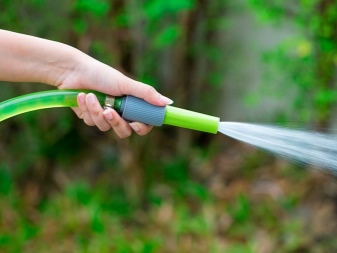
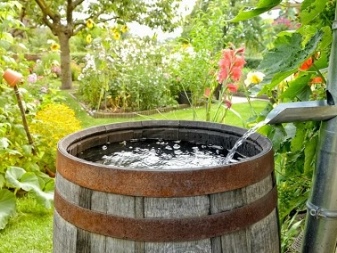
Poor soils need fertilizer - mullein, compost, mixed organic matter, for example, mineral dressings with horny flour, while the composition should not contain lime. Top dressing is carried out once a month until the plant stops blooming. An excess of minerals leads to active growth of stems, flowering decreases. After the inflorescence has withered, it must be removed if there is no purpose to provoke self-seeding. Higher grades require a garter. The frost resistance of the culture is high, therefore, the plant is not covered for the winter period.
Competent care helps prevent insect attacks and various plant diseases. In a weakened state, goldenrod is susceptible to powdery mildew and aster rust. A particularly dangerous environment for the development of dew is hot weather. Weak shoots must be removed immediately. If there was an excess of nitrogen in the top dressing, the risks of powdery mildew increase, but ash can reduce them to a minimum. In the case of any fungal diseases, fungicide preparations are used. If the plant is attacked by slugs or caterpillars, it is necessary to rob them and treat them with insecticidal agents.
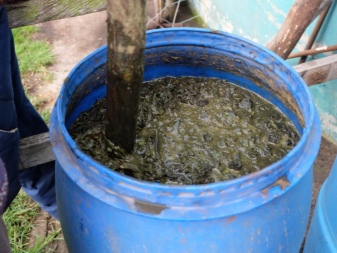

Reproduction methods
This representative of the flora reproduces in different ways: by seed, by dividing the bush, by cuttings. These processes do not create difficulties, therefore, they are available even to novice gardeners. Rooting usually occurs without problems.
Seeds
This method significantly reduces germination; fresh specimens must be used. Seeds that have been in place for over a year will not work. Landing in open ground is carried out in any spring month - it depends on the climate of the region. After disembarkation, the area is covered with polyethylene, cloth. Before planting, the soil is dug up, loosened, equal to a rake.
Seed material is laid out in a ditch at a decent distance. The sowing is covered with earth from the grooves, equal to the rake. After disembarkation, watering is carried out, it should not be allowed to dry out. After germination, after about 2-3 weeks, the seedlings are thinned out. There may be no flowering in the first year. To increase the percentage of germination, you can grow seedlings at home in containers with high-quality irrigation.
Important! The seed method is the most unclaimed among gardeners.
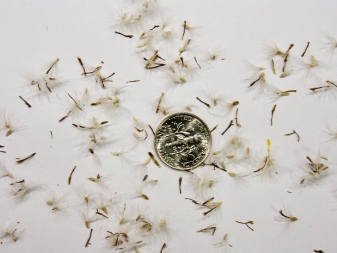
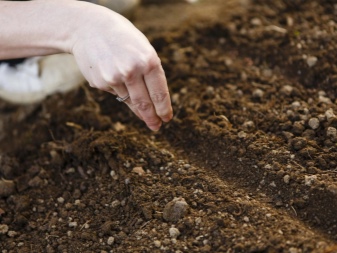
By dividing
This method is very simple and is therefore the most commonly used method. The bush is dug out, parts are cut off with a knife, you can gently tear it off with your hands. Selected seedlings are planted in selected zones, 40 cm apart. In the second year, the plant is already capable of producing root-type shoots, but it is better to postpone the division until the goldenrod is 4 years old. The event takes place in spring or autumn.
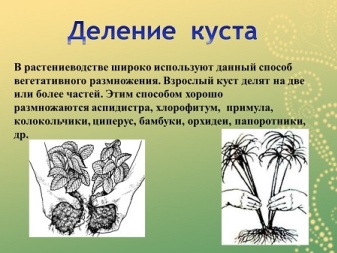
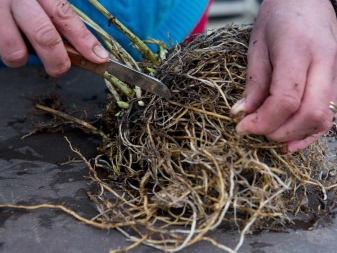
Cuttings
Cuttings are separated from the plant of the uterine type, from the upper zone of the plant, inflorescences are not welcome on them. The optimum length of the process is not less than 10, but also not more than 15 cm. The cut must be held in a solution that stimulates growth, after which rooting is carried out in any container filled with soil.The substrate can be made independently by mixing equal parts of sand and loose soil without fertilizers, you can buy it ready-made in the store. Cover the tray with glass on top, you can use cans or polyethylene and put it out in a sunny place.
After 2-3 weeks, the roots appear, the seedlings are ready for transplanting to a pre-selected permanent place.

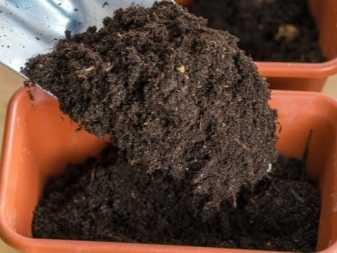
Use in landscape design
- This wild perennial grows well where there are no competitors that are too tall.
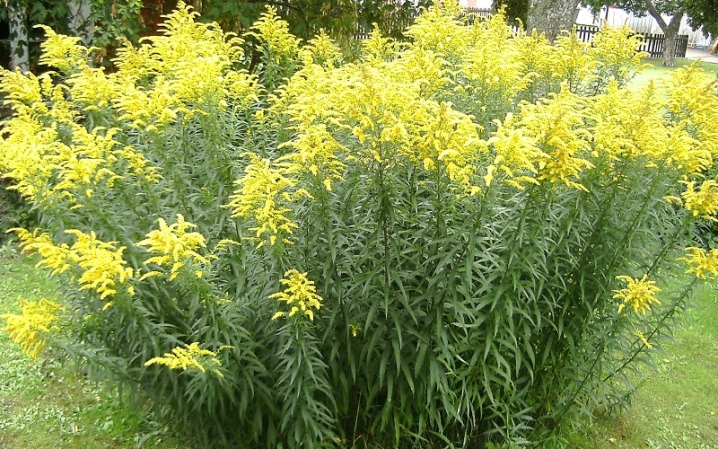
- It looks great in a flower bed, with low and tall representatives of the flora, with ferns, flowers.

- Decorative undersized goldenrod can decorate lawns, borders, rockeries.
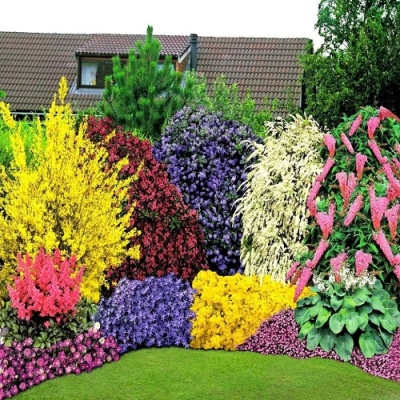
- High grades resembling arrows look great along fences, buildings.
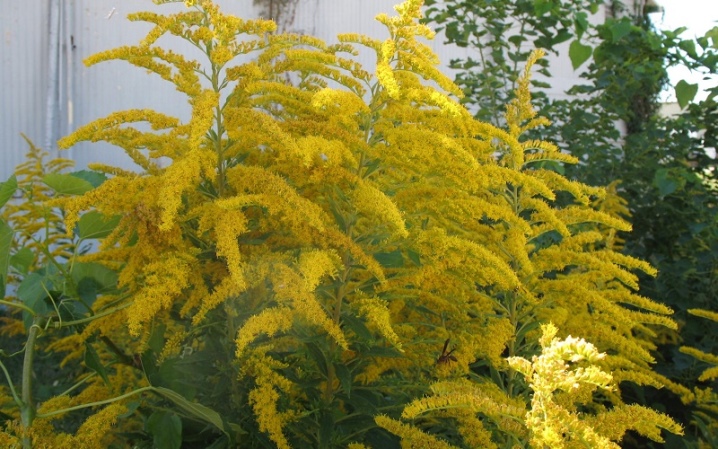
- This flower is a wonderful decoration for stone compositions and alpine hills.
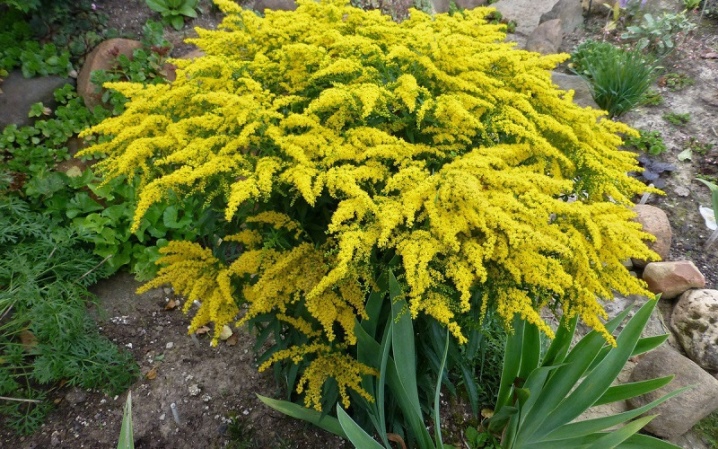
In the next video, you will find additional information on the medicinal properties and benefits of goldenrod on the site.







































































































The comment was sent successfully.